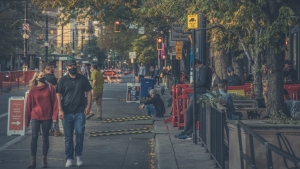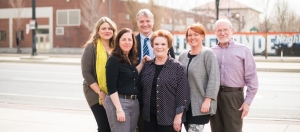Meet the 2020 Downtown Achievement Award Recipients
Each year, the Downtown Alliance recognizes extraordinary contributions to downtown’s vitality, safety and livability with the Downtown Achievement Awards at our annual State of Downtown event. Acknowledging the challenges that many faced in 2020, these award winners rose to the top in the Downtown Alliance’s nomination discussions.
Each of the 2020 Downtown Achievement Award recipients exemplifies what we can solve, accomplish and create when we work together,” said Dee Brewer, Executive Director of the Downtown Alliance. “Our downtown is better because of each of their contributions."
2020 Achievement Award Winners:
Fourth Street Clinic - Improving the Lives and Health of Homeless Utahns
For over 30 years, the Fourth Street Clinic has served homeless Utahns. Each year, the Clinic provides primary care, dental, behavioral health, specialty care and pharmacy services to over 5,000 homeless men, women and children. In 2019, the Clinic launched a state-of-the-art mobile healthcare unit that brings the clinic’s services to clients at eleven locations including Salt Lake's three homeless resource centers. In 2020, Fourth Street Clinic was on the frontline of COVID-19 screening and testing for individuals experiencing homelessness and completed over 8,000 tests. View Fourth Street Clinic's video profile below: 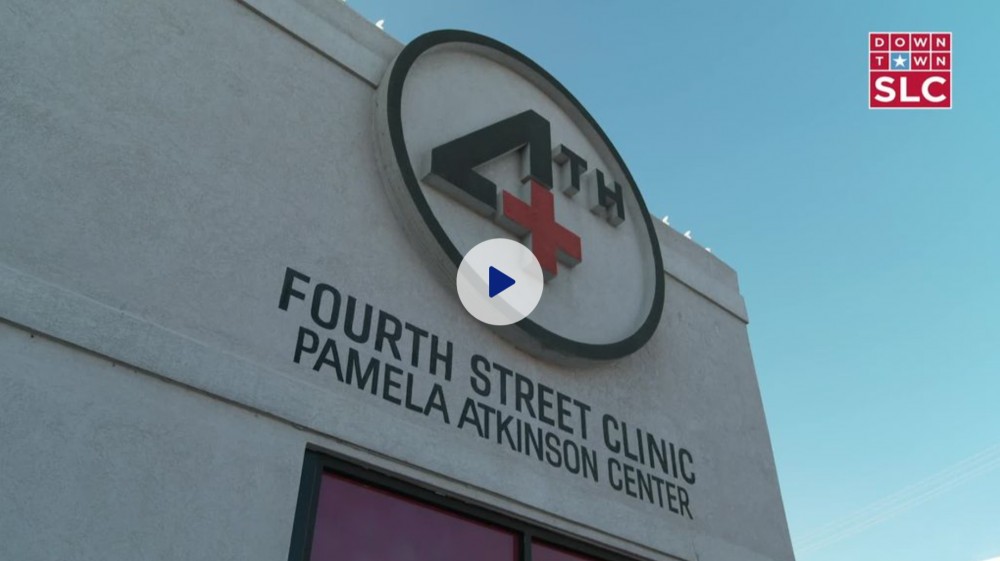
Caputo’s Market & Deli - Exemplary Leadership and Innovation During the Pandemic
Downtown restaurants and retailers felt an outsized impact of the COVID-19 pandemic. The healthy flow of typical customers--downtown workers, event patrons, and business travelers was reduced to a trickle. As businesses scrambled to adapt to safely serve guests, Caputo's Market was exemplary in their quick adaptation. They recognized the health imperative to do business differently. They reassigned employees and communicated their safety measures and service adaptations to customers. View Caputo's video profile below. 
Plan-B Theatre - 30 Years of Amplifying Diverse Utah Voices
Since 1991, Plan-B Theatre has produced unique and socially conscious theatre created by Utah playwrights. Plan-B nourishes our local community of playwrights. It develops relationships with playwrights rather than just developing plays. Plan-B represents the many faces of Salt Lake City. View Plan-B's video profile below.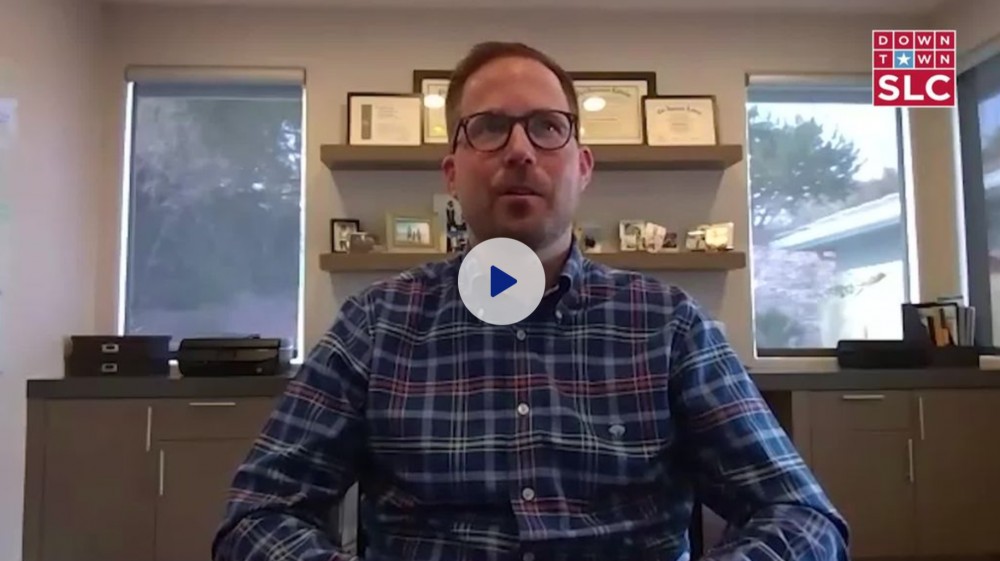
Domain Companies & GIV Development - Progressive Mixed-Use Development at Avia and Mya
Avia and Mya are two distinct buildings in one impressive new Transit Oriented Development that is successfully balancing attention to design, carbon neutrality and affordability. The mixed-income environment leverages diversity as a key amenity at this downtown mixed-use, mid-rise development.
GIV has developed successfully in the Salt Lake market over the last decade. Domain Companies is bringing new energy and capital to Salt Lake. This is Domain’s first project in the West. View Avia and Mya's video profile below.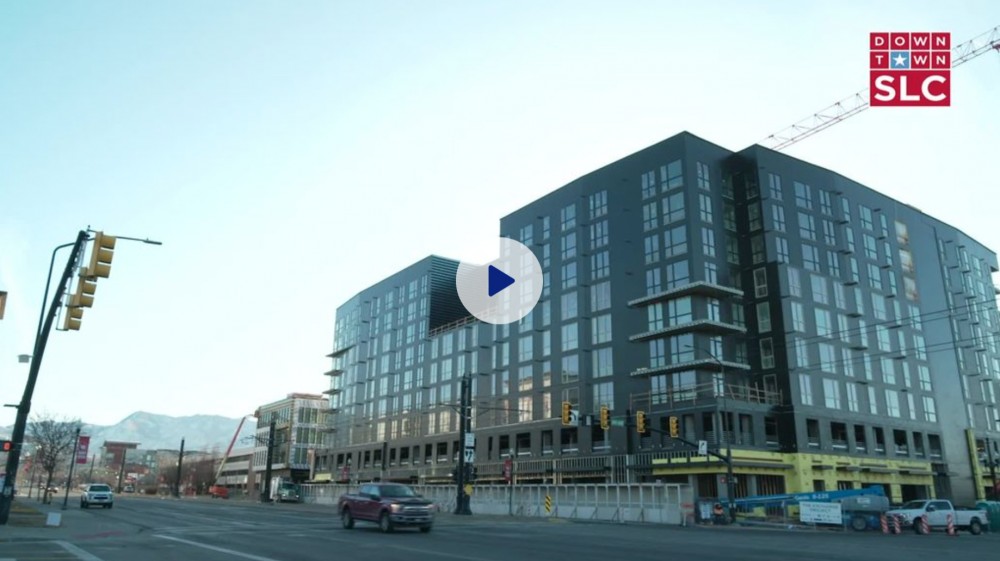
Bill Knowles - Downtown Construction Ombudsman
At the Downtown Achievement Awards, the Vasilios Priskos Honors were presented to Bill Knowles, Downtown Ombudsman. Bill Knowles has been an ombudsman for construction mitigation on key downtown developments over the last 25 years. These include the Eccles Theater and 111 Main office tower, the original TRAX construction and currently, 95 State tower. View Bill Knowles' video profile below.
Remembering Twelve Downtown Moments from 2019
Dee Brewer, Executive Director, Downtown Alliance
In 2020 I think we will be astonished by the pace of our capital city’s dramatic evolution. New workers, new residents and new businesses will move downtown and over two million square feet of new space will be under construction to support this unprecedented growth. Additionally, iconic Temple Square will begin a massive renovation. As we step forward into 2020, please allow the Alliance a quick glance over our shoulder at 2019 to celebrate twelve moments of downtown progress, planning and realization.
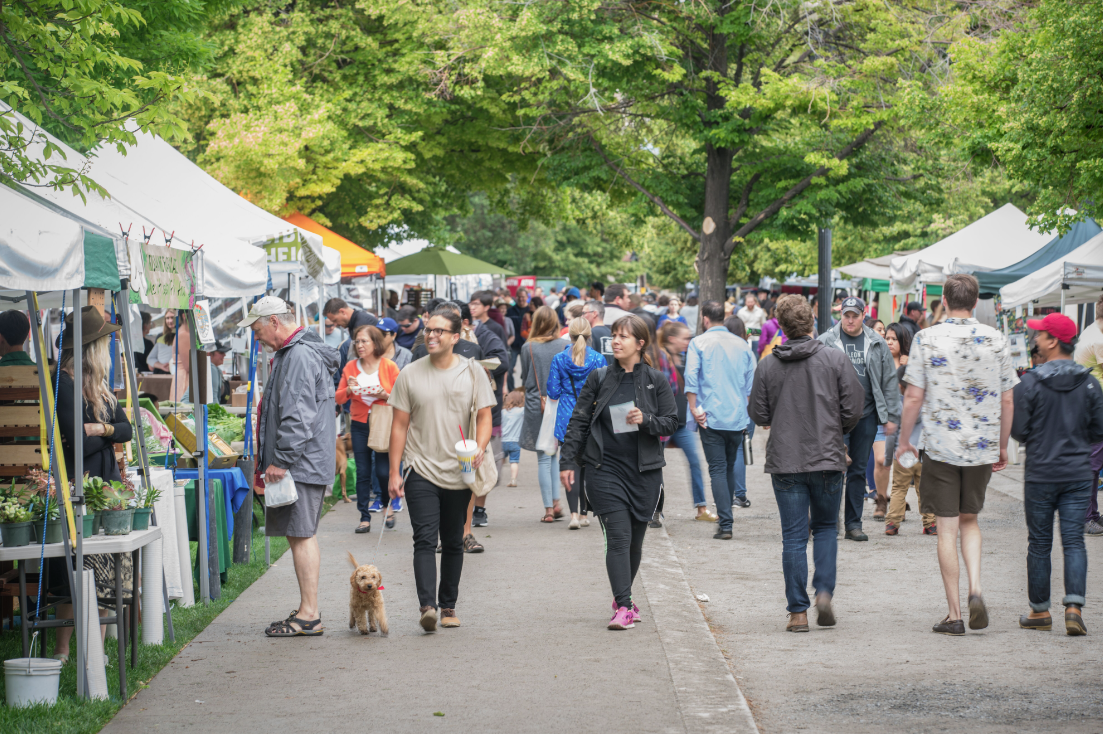
The 28th season of the Farmers Market drew over 200,000 visits to downtown.

Mayoral candidates Luz Escamilla and Erin Mendenhall debated the issues making history as two female candidates vied for the Mayor’s seat.
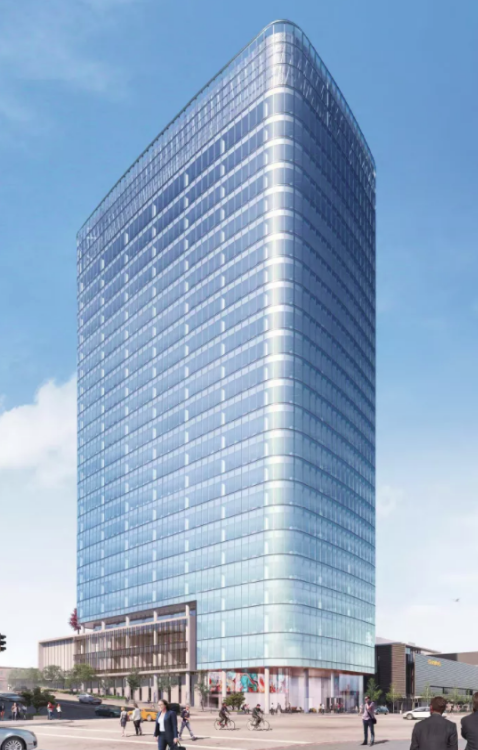
Construction began on the 95 State tower.
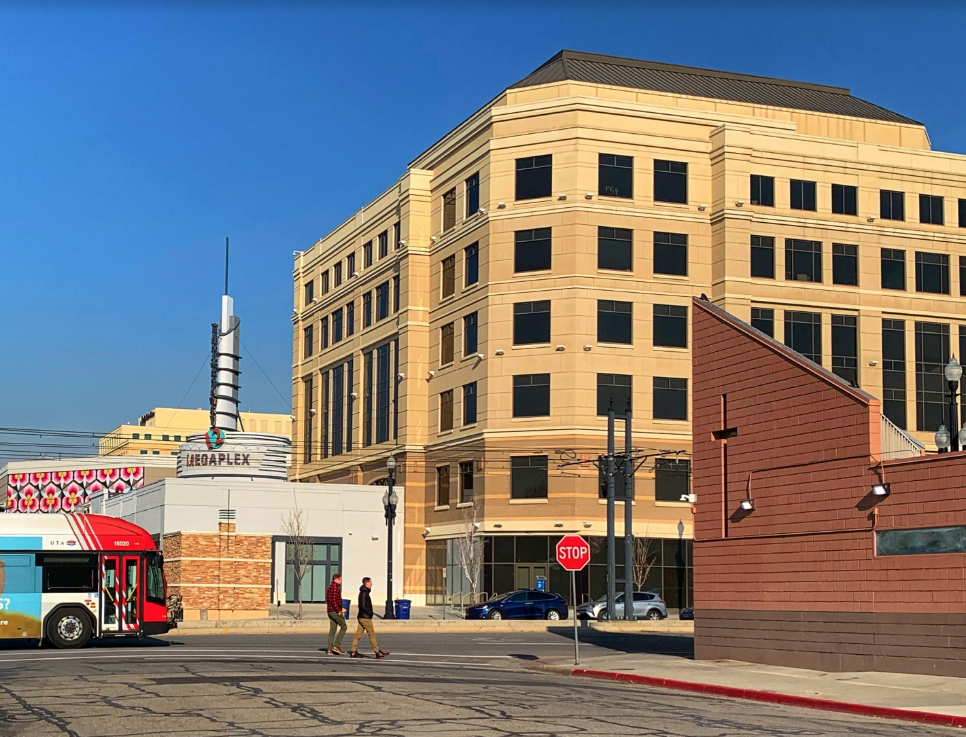
Unrestricted access was restored on Rio Grande Avenue after three new and improved resource centers were opened to serve people in need of shelter and services.

Art flourishes downtown! And THE BLOCKS built a phone app so you can learn more about public art and murals that adorn our streets. Edison Street by Chris Peterson is our newest large-scale mural.

Mayor Jackie Biskupski welcomed the United Nations Civil Society Conference to SLC.
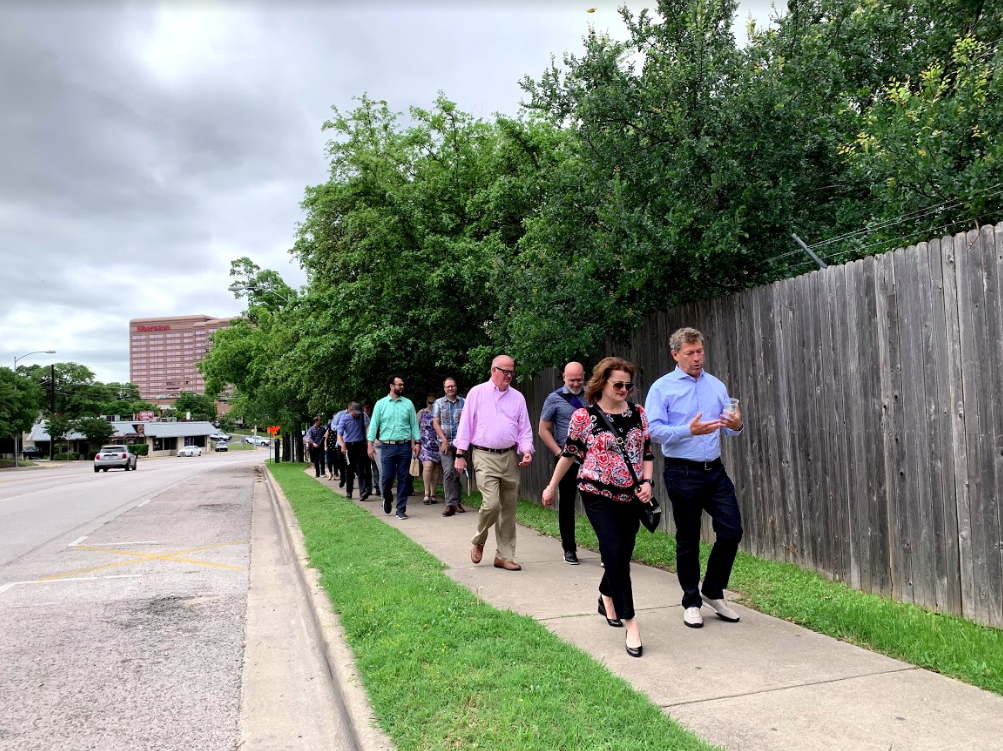
City leaders explored Austin for learnings about tech development, night-time economy opportunities, public-private partnerships and transportation.
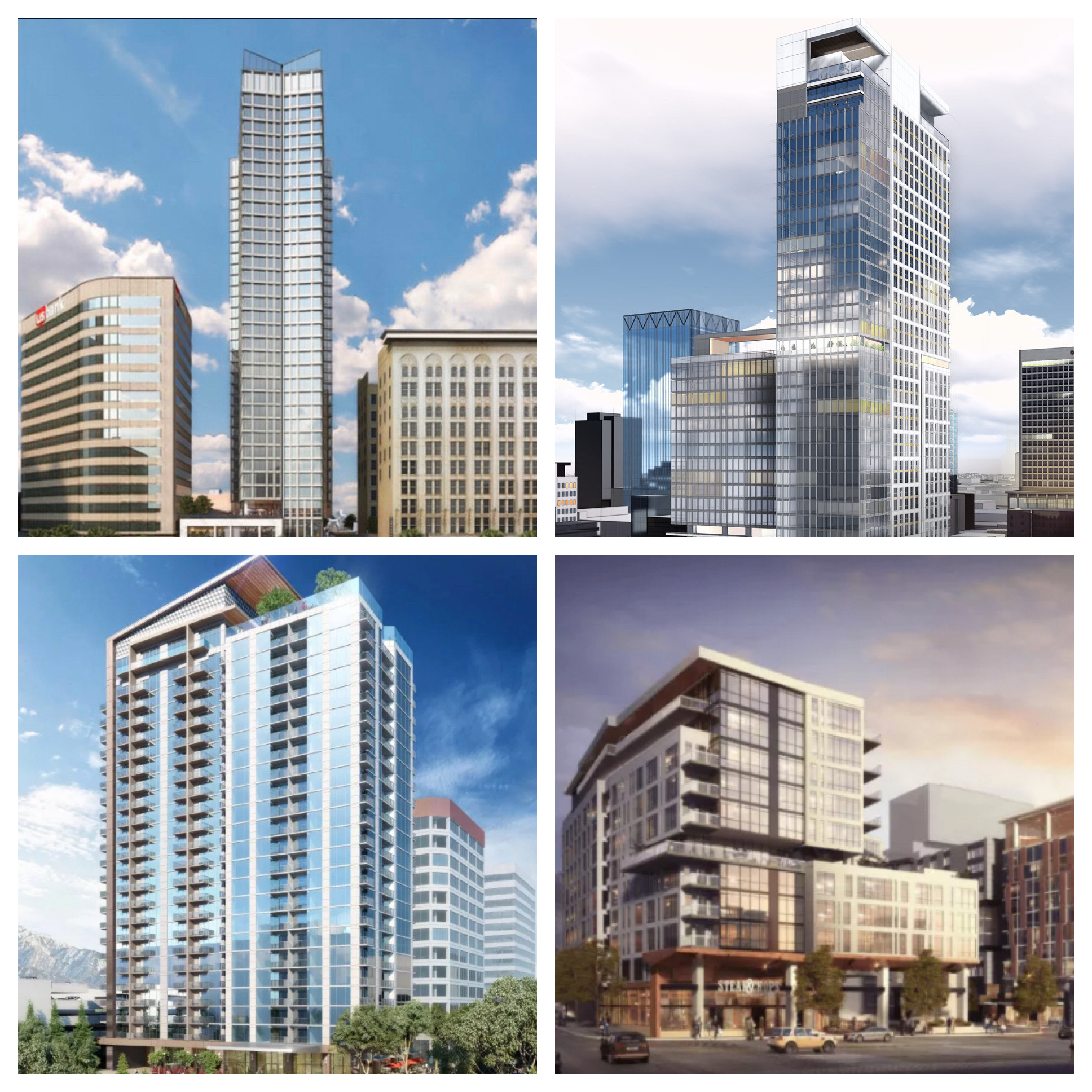
Over 100 stories of residential construction were announced at four projects on Main Street, State Street and 300 West.
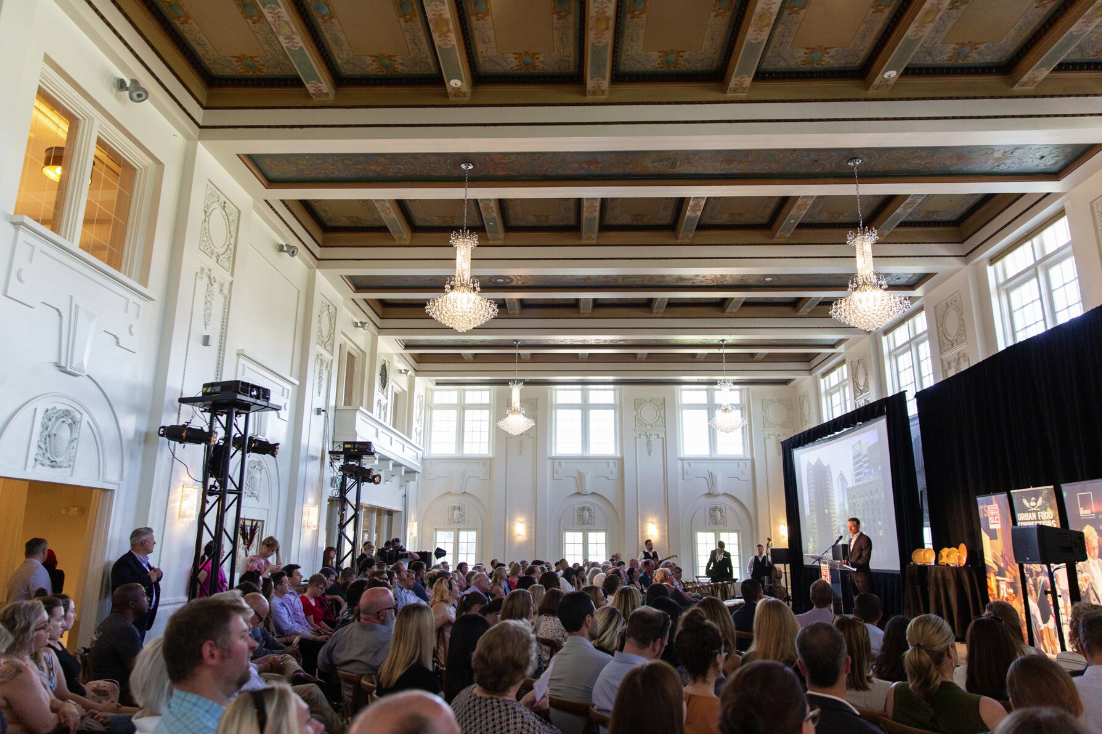
Downtown leaders celebrated Downtown Achievement Award winners: Tin Angel, Artspace and Excellence in the Community.

City nights! Choose a night: Twilight Concerts, Last Hurrah!, Festa Italiana, Living Traditions, Urban Arts Festival or one of a hundred other events!
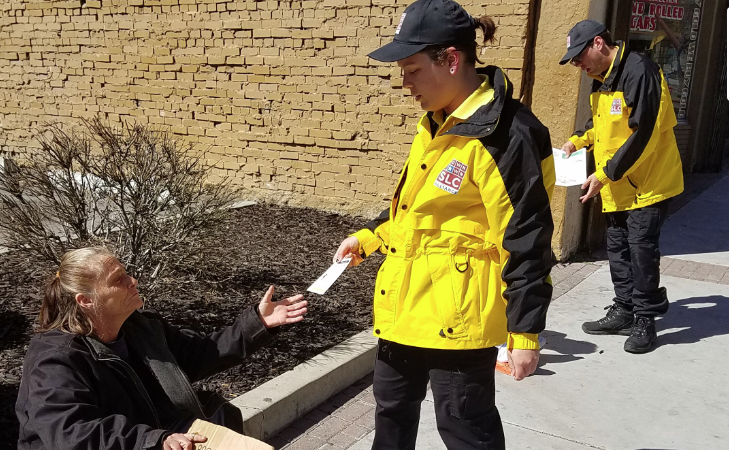
Each day, our street ambassadors helped dozens of people in need get to shelter and service providers, they helped business owners keep their neighborhoods clean and safe, and they helped visitors find their way to restaurants and shopping.

And last but not least, on December 30, financing is scheduled to close on a 700 room convention center hotel enhancing Salt Lake’s appeal for city-wide high-spend conventions.
Homeless Shelters Transition: We Must Provide Refuge and Assistance to Those in Need
from Derek Miller, President & CEO, Salt Lake Chamber and Downtown Alliance
As Shelter the Homeless is following through on plans to build and staff new resource centers and has closed the Road Home shelter on Rio Grande Avenue, some are expressing concern that people in need will literally be left out in the cold. These concerns are borne out of empathy and compassion — great qualities of our community.
Fortunately, the Road Home and other direct service providers have committed that people seeking shelter will be provided for through the transition with arranged housing, the new facilities and overflow shelter mechanisms. Thanks is due to Catholic Community Services, Volunteers of America and The Road Home for operating the new resource centers.
The Salt Lake Chamber and Downtown Alliance support the new Resource Center Model that Shelter the Homeless is implementing. We recognize that the end goal is not getting people into a temporary shelter, the goal is to help people achieve housing and income stability, food security, and get the health services they need.
Yes, there is potential for oversight in a large-scale transition. Shelter the Homeless partners must manage the transition this winter with outreach, communications and transportation solutions.
In addition to the new dispersed resource centers, the 4th Street Clinic, Catholic Community Services and St. Vincent’s will also operate some services downtown. The downtown community must stay engaged in helping people access the services they need at the resource centers best suited to serve them.
Beyond this involvement, we must also increase efforts and broaden strategies to engage the service-resistant people currently camping on the streets and in the foothills. We must help them find sustainable shelter solutions, and get those in need of mental health and drug treatment care. Addressing the needs of those camping on the streets is a uniquely difficult challenge and distinct from addressing the needs of those transitioning to the new shelter locations.
Downtown Alliance Street Ambassadors patrol the Central Business District daily to engage people in need, direct them to resources, arrange transportation and schedule appointments for them with caseworkers in the new resource centers.
How can you help? Give to the service providers that can positively intervene and support individuals in need. Please donate directly to Shelter the Homeless to double your donation due to the generosity of the Miller Family match. We strongly encourage people not to give to panhandlers, which perpetuates their dependence on the unsustainable and unsafe path of living and sleeping on the street.
Anyone seeking shelter or resources is encouraged to call 801-990-9999
How to Give Responsibly During the Holidays
When enjoying the holiday magic in downtown Salt Lake City, generous Utahns are often prompted to help people who need shelter, a meal, warm clothing or health care. Speaking plainly: giving to a panhandler does not help that person; it perpetuates their living on the street. There are wonderful service providers in our community that reach out daily to those in need and are truly helping by providing shelter, housing, healthcare, clothing and meals.
Here are six ways to give direct support to effective service providers. You can give knowing that your gift will truly help those in need.
Home4change.org -- Larry H. and Gail Miller Family Foundation:
During the holiday season, you can double your donation when you give to Home 4 Change. Thanks to a generous contribution from the Miller Family Foundation, every dollar you donate here will be matched, dollar for dollar, until the $10 million dollar goal is reached.
Give at home4change.org
HOST (Homeless Outreach Service Team):
The Homeless Outreach Service Team, aka HOST, is a partnership with the SLCPD and homeless service providers to connect homeless individuals with social services and resources. 100% of donations go to the Pamela J. Atkinson foundation and are dispersed to local homeless services providers.
Give at https://slchost.org/
Candy Cane Corner:
The Candy Cane Corner provides a holiday shopping experience for families participating in services at the YWCA, the Road Home and VOA Youth Resource Center. Shoppers can pick out a variety of toys and clothes to give one another and stay warm during the cold winter months.
See their top 10 donation needs and give at http://candycanecornerslc.org/donation
Giving Machine:
In the lobby of the Joseph Smith Memorial Building, you’ll find two vending “giving” machines stocked with philanthropic opportunities. You can choose from local and global giving options that range from food and medicine to soccer balls, eye care and more.
Learn more about the giving machines at https://www.mormon.org/christmas/giving-machines
Utah Food Bank:
Last year, the Utah Food Bank distributed 32.7 million meals. Organize your family and friends and hold your own food drive or donate at any Harmons grocery store. Cash donations allow the food bank to buy in bulk and provide more meals for more people.
Give at utahfoodbank.org
Volunteer:
Many Utah service providers rely heavily on volunteer work to operate their programs. Serve a dinner or help with activities and programming. Learn more about service providers that accept volunteers at the HOST website.
Revitalizing Rio Grande
“You have two options: either you can go to jail, or, we can check you into a treatment facility.”
Law enforcement officers found themselves laying out these options to hundreds of individuals in the Rio Grande Neighborhood last August after crime, violence and general lawlessness hit a tipping point. Open air drug dealing, criminal mischief, violence against homeless individuals and other nefarious activities were all too common sights for anyone who happened to be in the area. Largely stemming from a combination of mental health problems, an affordable housing shortage and a nationwide opioid crisis, the state of 500 West was comparable to the fictional setting of Baltimore’s Hamsterdam in HBO’s crime series “The Wire”.
To add fuel to the fire, jail beds were sparse and arrests were reserved only for the most violent offenders. Law enforcement’s hands were cuffed as members of a drug cartel continued to prey upon a vulnerable population. The boiling point came in the summer of 2017 as a string of homicides and shootings rocked the Rio Grande neighborhood. Leaders from the State, City and County teamed up with local service providers and the police to come up with a plan to remedy the unsustainable situation on 500 West. What transpired was an unprecedented three-step, multi-agency effort that would help transform the neighborhood.
Nearly 10 months into Operation Rio Grande, we caught up with four individuals who have been directly affected and involved in the operation to understand the changes that have happened in the neighborhood.
Wendell Rivera - Odyssey House
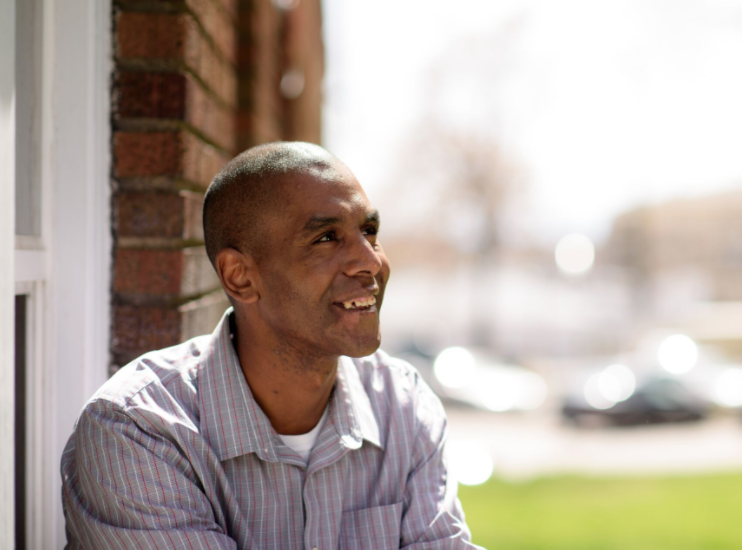
Also known as “the block” by its residents, the Rio Grande neighborhood served as a haven for those suffering from drug addictions as well as those who were simply down on their luck. Among those suffering from addiction was Wendell Rivera.
“During my time on the block, we did what we wanted, when we wanted, how we wanted to. Nobody could say or do anything, not even the cops.” Wendell had been living in the neighborhood for two years before Operation Rio Grande started. Like many of its residents, Wendell was addicted to heroin which was always readily available.
A father of two children, Wendell was a graduate of the Odyssey House where he had already worked on his addiction. After a string of bad luck, Wendell fell into to using once again. “I had sold everything. I lost our house, our car and before I was about to become completely homeless, I found a place for my kids to live. Starting that night and over the course of the next two years, I indulged heavily in my criminal behaviors. I was shoplifting and robbing so that I could use.”
Going in and out of jail was just part of the routine for many including Wendell, but the threat of arrest didn’t stop them from scoring drugs on a daily basis. “I was probably on my 20th arrest down there and I knew if I wanted to ever have a chance at being a father again I had to get sober.” After encouragement from his Odyssey House peers and one final arrest in which Wendell was offered treatment or serious jail time, he chose to return to the Odyssey House. “I knew if I didn’t take it I could die out there and never see my kids again.”
While he chose treatment as his way out, Wendell says he wasn’t too sure about Operation Rio Grande when it started. “I hated it and I was outraged, but I think that came from me being resistant to the help I needed.” In the months that Wendell has become clean, his perspective has changed. “I know there’s a lot of good people down there suffering and I hope they get the help they need, so I’m all for it. I know the people behind the curtains are rooting for us.”
Now well over 100 days sober and working as an Onboarding Coordinator for the Odyssey House, Wendell looks to keep moving forward. He hopes to eventually return to school, continue his work and see his kids.
Matthew Melville - Catholic Community Services
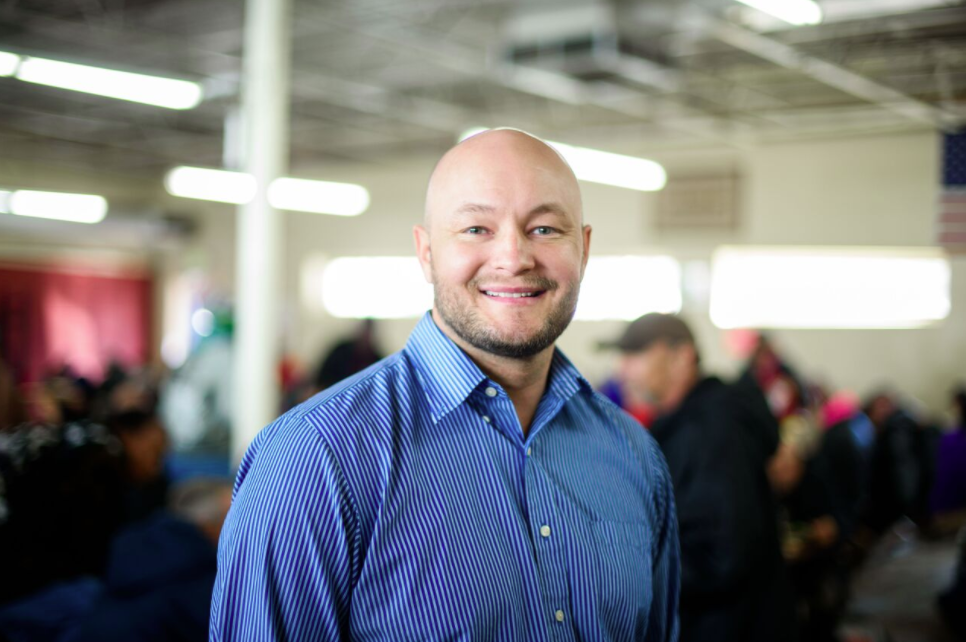
Situated in the heart of the Rio Grande neighborhood, the Weigand Center and St. Vincent de Paul Dining Hall serve about 450 people experiencing homelessness every day. Providing shelter from the elements, holding job training and dishing out lunch and dinner are just a few of the services they offer to help individuals get back on their feet. When problems were at their worst, employees and people seeking services often feared for their safety.
“It was to a point where some of our employees even had knives pulled on them,” said Matthew Melville, who serves as the homeless services director for Catholic Community Services. “It can be a depressing place down here; people will reach for whatever they can get to cut the pain. The dealers were always here to prey upon our clients and those who were down on their luck.”
The services that Melville and his team provide are key for individuals who want to take the first step towards leaving homelessness. With a drive-thru drug trade and violence at their actual doorstep, most individuals and employees were hesitant to enter the neighborhood. “We had families down here that wouldn’t even dare walk across the street to go to the Road Home. People would say, ‘Hey, do you work here? Can you walk me over?’... because it was just that bad.”
But, that was then, and this is now. Thanks to a “safe space” road closure created by the operation, visitors of the Road Home and Weigand Center are using the shelters at a higher rate. “We’re averaging about 100 extra people a day that we wouldn’t have seen before the operation.” Melville credits this to the Operation Rio Grande efforts. “What we have now is a culture of compliance. The neighborhood has been completely transformed. I’m not offered drugs anymore, and violence has been cut down a lot.”
While there have been visible and quantifiable improvements in the neighborhood, there is still plenty of work and healing that remains. “We need more funding for treatment beds, and we need to continue the dignity of work phase. We’ve been hyper-focused on jobs and housing down here.” Phase three of Operation Rio Grande focuses on exactly that. The Dignity of Work phase prepares individuals for the workplace through workshops, education and ultimately job placement. In addition to continuing the efforts that have taken place already, Melville stressed the importance of public support by underscoring that this is a community-wide issue, not downtown’s alone. “There are many different ways the community can give. You can give time, money or simply by going to your community council meetings and staying informed.”
Sergeant Sam Wolf - Salt Lake City Police Department
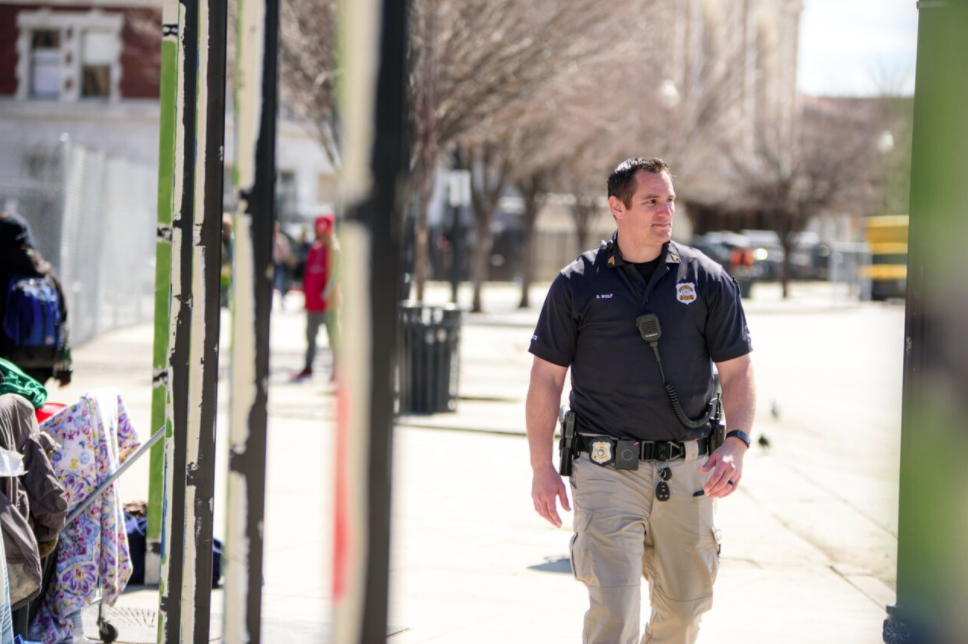
When Sergeant Sam Wolf patrols 500 West, he does so by calling its residents by their names and nicknames. “Hey Widow, is there anything we can do for you today? Edie, is there any chance we can connect you with services?” It’s safe to say that few know the Rio Grande Neighborhood quite like Sergeant Wolf does.
Before being promoted to Sergeant of the Community Intelligence Unit, Wolf served as the head of the SLCPD Bike Squad. His team was based out of the Community Connection Center directly across the street from the Road Home shelter on 500 West. Before Operation Rio Grande, there was little police could do to enforce the law and help those who needed it. Jail space was at a premium with beds reserved solely for the most violent offenders. This often left police without the power of arrest, opting instead to writing a ticket or arresting and releasing. Wolf says things have changed dramatically.
“Out here, there were no rules,” Wolf says. “I used to go up and down 5th west every day, and I’d count 100-plus makeshift shelters and tents. Now, it’s about 10 to 15. The reduction has been huge, and you can see it.”
Wolf attributes this reduction in the population to additional funds and officers from Operation Rio Grande, as well as the combination of arresting criminals who took advantage of the homeless population and providing proper services to those who need them. Officers and social workers can now better identify the needs of new clients, shelter-resistant individuals and criminal elements in the neighborhood.
The neighborhood certainly appears safer, but is it? Crime in the neighborhood is down a staggering 48 percent in the last year to date. Paired together, the numbers and visuals don’t lie.
For Wolf and his team, less crime means more time to help. “One of our social workers \ told me about an individual we’ve met with and offered services to 56 times. Finally, on the 57th time, they accepted help.” More help is on the way with preventative programs and three new needs-based resource centers that will open around the Salt Lake Valley in 2019.
Matt Bourgeois - Rio Grande Cafe
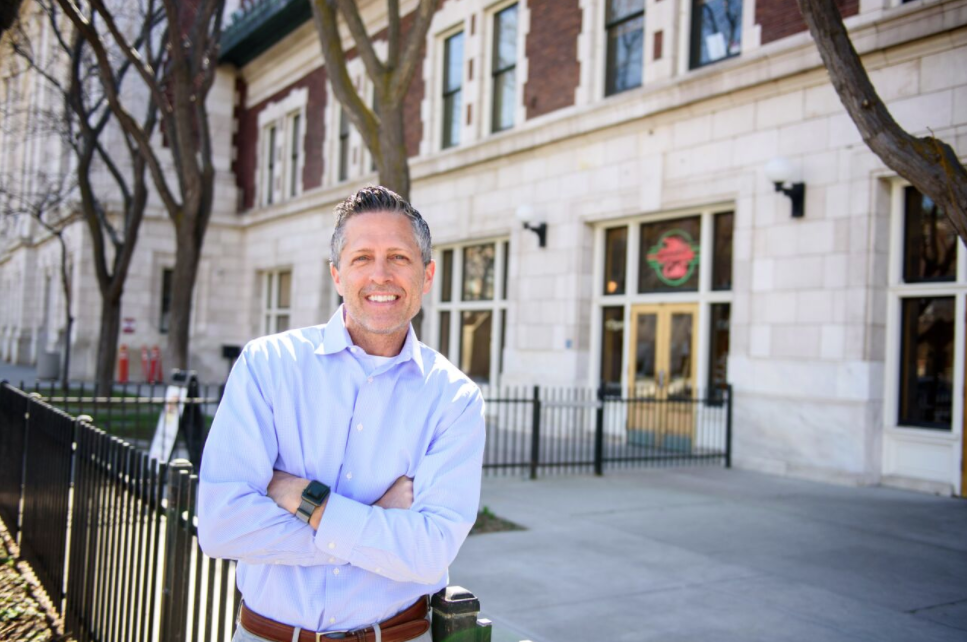
From ghostly tales of the purple lady, to the taco lady and the toy railroad tracks that hover over the bar, Rio Grande Cafe has been a staple in the downtown food community since Pete Henderson opened up shop in 1981. Now under new ownership, the cafe has experienced the highs and lows of the neighborhood while maintaining their traditional Mexican faire.
When Matt Bourgeois and his partners purchased the Rio Grande Cafe a year ago, the state of the neighborhood would have scared away most investors. However, Bourgeois knew that the neighborhood had major potential. “We thought we’d have to deal with the situation down here for about two, maybe three years before it would improve. When we bought this place the optics were terrible, you’d park in your car and step over needles just to get into the restaurant.”
Two years turned into less than one, and the results of the operation have been beneficial for the restaurant and its neighbors. “I’ve talked to some of the individuals who are staying at the shelter and they feel safer, we feel safer—so from our perspective down here it’s been a huge win.”
When Bourgeois thinks about the future of the neighborhood, a smile comes over his face as if he knows something the rest of us have yet to find out. “There’s $8 million going into a neighboring hotel, $100 million into The Gateway and we have the proposed Public Market. I’m excited—this should be one of SLC’s best neighborhoods, and I think it will be.”
How You Can Help:
Serve a meal at St. Vincents de Paul. Contact ccsutah.org and check under the volunteer tab.
If you see something, say something!
Please do not give to panhandlers. Help them more by giving directly to homeless service providers.
Learn more about Operation Rio Grande at operationriogrande.utah.gov
Turn spare change into real change at Red HOST (Homeless Outreach Service Team) parking meters around Downtown SLC.
Volunteer at resource centers.
Give money to service providers.
Stay informed by going to your community council meetings.
It Takes A Team
Our city is at its best when we come together to solve big problems.
A strong sense of community stewardship and teamwork helps to set downtown apart from other urban centers in the West. As our city has looked for new ways to help homeless individuals and families, a team-based approach is making a difference in programs designed to move people out of homelessness and into mainstream life.
Clean Team
Life on the streets can be dirty for Utah’s homeless population. Limited bathrooms and trash services sometimes create a lack of cleanliness in and around Pioneer Park and the Rio Grande Street. In September 2013, the Downtown Alliance, Salt Lake City and homeless service providers worked with Advantage Services created the Clean Team to help clean up the shelter neighborhood. Members of the Clean Team include 20 homeless residents and those living in supportive housing who have been hired to work part-time cleaning up trash and performing small property maintenance around the Rio Grande area and in Pioneer Park at 350 South 300 West.
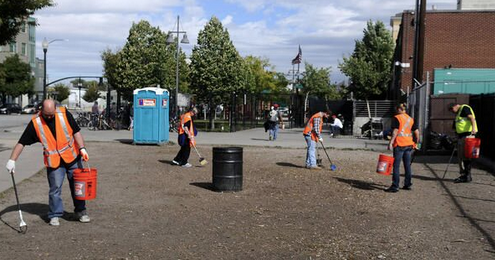
Camille Winnie, director of community services for the Downtown Alliance, helped to launch the program and has watched it make a difference in the lives of the workers and in the larger community.
“The goals of this program are to help team members get a resume, acquire some work experience and a positive reference and to introduce them to new things that they might not have done on their own,” Winnie says.
Advantage Services employs and services the Clean Team. Members earn minimum-wage and work four-hour shifts during the weekdays, picking up trash, shoveling snow, pulling weeds and power-washing sidewalks and buildings. There is even room for job growth within this program. Work on the Clean Team can lead to other employment opportunities with Advantage Services.
“This has been a productive program allowing people to take the next steps to get out of homelessness,” Winnie adds. “People have the opportunity and resources to better themselves and the community where they reside.”
“As a downtown resident, I have seen a real improvement in my neighborhood from the Clean Team,” said Christian Harrison, chair of the Downtown Community Council. “This program is literally cleaning up the neighborhood and giving people a chance to improve their own lives.”
Green Team
Last year, the Downtown Alliance, Wasatch Community Gardens (WCG) and Advantage Services joined forces to build on the success of the Clean Team with a new garden-based job training program for homeless women called the Green Team. Funded by Salt Lake City and on land donated by the city’s Redevelopment Agency, this new 10-month program empowers homeless women through urban farm education, job skills training and employment. “This is a transitional job program that is being used for women to gain skills to transition into a full-time job,” states Winnie. “The Green Team facilitates employment opportunities for homeless women and creates vibrant community spaces and community involvement.”
The plot, located behind The Gateway outdoor mall at 100 South 625 West, is in the process of being built. It is an ideal location for a job training garden since it is within walking distance of the majority of homeless services in Salt Lake City. This garden will enhance neighborhood appeal for current and future residents of the new housing developments in the neighborhood as well as for other downtown residents. Eight women are hired to work during the growing season, February through November. Green Team members learn to grow herbs and produce and receive life skills training on topics like personal resource management, health and wellness and interpersonal skills. They are in class one day a week and spend the other four days in the garden. Additionally, participants have a field trip each month to visit potential employers in food-related businesses in Salt Lake City. Crops grown in the Green Team garden will be sold at a subsidized rate to the Salt Lake Head Start program and will be used as a resource for the meals served at area shelters. Head Start currently produces over 4,000 hot, healthy meals each day for the children in their program.
It takes a village to make this garden grow. WCG manages the gardening operations and Advantage Services provides the hiring and HR functions, future job placement and job training and education components of the program. Downtown Alliance assists Advantage Services with their functions and helps establish collaborative partnerships with local businesses, residents and organizations.
HOST
Creating jobs is an obvious way for the less fortunate to earn money, but so is panhandling. Panhandling is an epidemic across the nation and Salt Lake City is not immune. Usually donating spare change to an individual only enhances their problem. This is where the Homeless Outreach Service Team (HOST) program is introduced to help “turn spare change into real change.”
HOST is a proactive and collaborative effort to move the community in Salt Lake City into a partnership with the police and homeless service providers to connect homeless individuals with social services and resources. Bright red donation meters are located throughout downtown and allow people to give spare change to the homeless rather than to those who ask for it on the streets. All money collected in the meters goes to the Pamela J. Atkinson foundation and are dispersed to local homeless services providers that provide help for those that need it most.

“This project was started based on the reality that no one ever panhandled their way out of homelessness,” Winnie says. “It’s teaching our community a better way to help.”
In 2010, the first 10 meters were installed. Six years later, 40 meters pepper the downtown scene. Zions Bank was the first to partner with Salt Lake City and the Downtown Alliance on the donation meters. Meters, street signs and stickers direct donors to a website (http://www.slchost.org/) if you don’t have change to spare. The campaign #HandupNotHandout has been created to get resources to the right people in our community who can make the biggest impact.
Jobs, volunteers and donations are ways to help those who face homelessness. But what is the best way to end homelessness? “Give them housing,” says Celeste Eggert, director of development for the Road Home. “Shelter is often the first step on the road home.”
The Road Home
The Road Home is a lead homeless service provider for the Salt Lake region. As a private non-profit social service agency, the Road Home offers emergency shelter and low-income housing options to single men, women and families experiencing homelessness. Staff provide personalized case management to help their clients identify and overcome the obstacles that have led them to becoming homeless. The shelter is open every day of the year and doesn’t turn people away if they are in need of a place to stay.
Logging 18 years at the largest homeless shelter in Utah has given Eggert a pretty good grasp on the topic. “For 90% of the clients we serve, they experience a short, one time period of homelessness and just need a little assistance to get back on their feet and then we never see them again,” says Eggert. “We find that the other 10% have something deeper causing them to become homeless and stay homeless for an extended period of time.” Case managers work closely with these clients to help connect them with services that will help them overcome the barriers causing them to be homeless.
That connection, with services and resources, can only happen in an environment that is built on teams. No individual or organization can solve homelessness singlehandedly. It takes a strategic and thoughtful approach that leverages the strengths of multiple entities to help people who lose their homes.
When an individual or family comes to the Road Home, they are provided with basic needs. The emergency services shelter offers assistance to low-income and homeless individuals on a walk-in basis while the family shelter helps meet the needs for families with children. Case managers are assigned to each family and select single clients to help them develop a plan for housing.
Over the next few years, the Road Home will continue to offer services as part of an integrated team approach that also includes other agencies, organizations and government entities. Instead of providing emergency shelter in a single location, additional facilities will be built that will care for distinct populations and additional resources will go towards preventing homelessness and treating the root causes of homelessness instead of just providing emergency services.
The Road Home is already lauded as a national leader for finding solutions for people who have been homeless for a year or more. In the Rapid Rehousing program, families receive a small amount of funding to allow payments for utility debts, deposits and rental assistance as well as a strong case management component. Once in housing, families rarely need to return to emergency shelter again.
For the small number of families and individuals who have a greater need for supportive services, the Road Home manages several Permanent Supportive Housing programs, including Palmer Court. Palmer Court is a 201 unit apartment complex for formerly chronically homeless families and individuals with mental illness and substance abuse disorders.
As part of a regional team-based approach, the Road Home will work even more closely with other providers like Catholic Community Services, The Fourth Street Clinic, the Salt Lake Mission, Crossroads Urban Center and local, regional and state governments to identify concrete goals to prevent people from becoming homeless and to get them stabilized and into housing as quickly as possible.
“The services that these teams offer exist by help and generosity of our community,” says Eggert. “The city and volunteers step up to support all of us.”
A Better Way to Give
“I commit to helping homeless people in our community. I will work to support service providers, religious organizations and private charities to offer housing, food, substance abuse counseling, mental health support, childcare, job training skills and social work. I support a strategic and comprehensive approach to ending homelessness.”
Above is the charter for the HOST program, signed by hundreds of community leaders. This collaborative effort between the SLC Police Department and homeless service providers, HOST aims to connect homeless individuals with social services and resources.
Chiefly recognizable from the bright red painted meters in the downtown core, the HOST program does collect donations, which are dispersed to local homeless services providers that provide help for those that need it most. But, the program encompasses much more than collecting funds. The goal of these meters, as well as the HOST program, is an educational resource to communicate the best way to give to the most vulnerable members of our community.
The HOST Charter also identified five key missions: share (financial resources, time & talents), give (to charities, instead of panhandlers), lead (in circles of influence), teach (others the best way to give) and create (dignity and meaningful change in the lives of others). These initiatives can easily be summed up with the mission to direct donations to service providers, rather than individual panhandlers, as a better way to give.
Simply put, giving money to panhandlers is an ineffective way to give, and usually hurts more than it helps. While it feels as though you’re doing the right thing in helping another who is asking for assistance, there is a better way to give. How do you know that money will be used for its intended purpose? How do you know that person is actually homeless? Or supporting a drug habits? Fact is, it is impossible to know. This is where the HOST program steps in, and ensures donations are going to the proper people, places and purposes.
Salt Lake City is one of the most generous cities in the US, perhaps even the world. Utahns genuinely want to help others; however, the most effective way to donate is directly to service providers, who in turn helps those who need it most. As an example, a small donation of five dollars barely provides a single meal for one person via panhandling. That same five dollars can feed up to four people when donated to a shelter or mission. Service providers are simply more effective than single donations, and ensure help is given in positive forms.
Homeless Service Providers
Consider donating time, money or other resources directly to these organizations, or your local church group:
Catholic Community Services
Crossroads Urban Center
Dinner at Vinny's
Fourth Street Clinic
Homeless Youth Resource Center
Homeless Outreach Program
Rescue Mission
SLCGiving.org
The Road Home
Utah Food Bank
Utahns Against Hunger
Veterans Affairs
VOA Outreach
211 INFO
Meet Three People Giving a Hand Up Instead of a Handout
In his book Triumph of the City, Harvard Professor Edward Glaeser says “cities don't make people poor; they attract poor people. The flow of less advantaged people into cities demonstrates urban strength, not weakness.”
Downtown is Utah’s center for culture, commerce and entertainment. It is our state’s capital and historic center for finance, law, media and creative enterprise. But at the core of this urban center are the people who make it dynamic and diverse. Downtown plays a role in the lives of many people, including homeless individuals and families, as well as those fighting addiction.
Below are three individuals lending their talents and experience caring and advocating for the community who rely on our downtown for recovery and services.
Celeste Eggert: Advocate & Guardian
When most of us consider what we do and where we go to work, nouns such as “job” or “career” are used. Celeste Eggert instead describes her path as “service” and “calling” in defining her 17 years at the Road Home. Celeste began as a case manager at the agency and has served as Director of Development for the past eleven years.
“It is so difficult to pick a single moment that epitomizes why I love my job,” Celeste states. “I think everytime I see a family or an individual move into housing it reaffirms to me the work we are doing is making a difference. I see people every day that others may think are beyond hope and can't possibly find a way out of homelessness and yet they do. Working at The Road Home reaffirms to me every day that every human being is worthy of a second chance.”
The Road Home is many things to many people, and Celeste describes their role as a stepping stone and a resource for families and individuals who are struggling to find a way out of homelessness. The cliche in marketing materials is true: “we are a hand up, not a hand out.” Clients do the work as they move out of homelessness and back into our community. In fact, 63 percent of the people who come through The Road Home's doors stay for 6 weeks or less.
Celeste sees her role as two-fold: first as an advocate for people experiencing homelessness. “So many people have preconceived ideas of what homelessness is and who the homeless are. Part of my role is an opportunity to educate the public about the work of our agency and this extremely complex issue.” The humanity of The Road Home can be found in looking at the words Celeste uses to describe who they are and what the do. For example, using the word “client” offers a far different image than other words may conjure when thinking of this part of our community’s population. Secondly, as a guardian of our agency's mission, "To help people out of homelessness and back into our community." The Road Home exists because of the generosity of our community. They entrust the staff to serve those experiencing homelessness in the best, most efficient manner possible. “It is a great responsibility and one that we take very seriously.“

Randall Carlisle: One Day at a Time, One Person at a Time.
You may recognize Randall as the face and voice of the evening news, having worked as a reporter and anchor in local television for nearly three decades. Or perhaps you recognize his smile and helpful personality behind the customer service desk at Harmons. A downtown resident for as long as he’s been on the airwaves, what you might not know about Randall is his personal journey as a recovering alcoholic.
Currently sober for three-and-a-half years, Randall generously gives his time and shares his experience towards helping others battling addiction and seeking recovery. The Rio Grande neighborhood is home to numerous 12-step programs, including an AA meeting Randall volunteers to lead bi-weekly.
One of Randall’s motivating factors to become a part of the solution was to begin instilling hope in others. Believing in a “one-day-at-a-time” approach in staying sober,
He also points to his role as a journalist, and being assigned stories about the HOST program as a catalyst to get involved. “I saw what they were doing with this multi-faceted program, and they offered me the space to lead these meetings.” That was six months ago.
Since then, HOST, a collaborative approach between city leaders, SLC Police, the Downtown Alliance and other service providers has helped many people. “The best way we can deal with people is one-on-one, and that includes the HOST program. Whether you help someone out with substance abuse, lack of housing or lack of a job, then you’ve really made a difference in life.” HOST is an acronym for Homeless Outreach Service Team, defined as a proactive and collaborative effort to move the community beyond enforcement of order maintenance issues – public intoxication, disorderly conduct, etc. – to a partnership with homeless service providers that connects homeless individuals with social services and resources.
A firm believer that recovery programs can help, Randall is also quick to point out that “substance abuse and mental illness are top-tier issues” for the individuals who frequent the neighborhood. “Throughout these past six months, I’ve seen people stay clean and sober, find jobs and housing. Unfortunately, that’s in the minority and there are more failures than success stories.”
To understand how to help those suffering from addiction starts with understanding the environment these individuals face each day. The current cluster of services downtown, while convenient from a geographic perspective, also breeds an inhospitable climate for those seeking recovery, as well as for children and families.
When looking towards the future, Randall is incredibly hopeful efforts by Mayor McAdams and Mayor Biskupski to collaborate with state and private funding will change the environment in the Rio Grande neighborhood. Spreading some of the services, even a few blocks will pay great dividends to individuals in the area, as well as surrounding businesses.
Like most public and private leaders, Randal expects downtown to play a continuing role is aiding recovery and minimizing homelessness. “Downtown embraces everyone. There is a friendly climate, regardless of race, gender, sexual identity or walk in life. The homeless population is integral to every downtown around the county, and in my opinion it enhances the experience of living downtown. You can see the diversity. It’s healthy for society.”

Mayor Ben McAdams: Collective Impact
Mayor McAdams is taking serious aim at minimizing homelessness by getting to the root causes, as well as changing the way services are administered in Salt Lake County. The words “Collective Impact” have been used to describe the process and strategy. The nexus of this study and plan began several years ago as problems became more serious in the downtown area, with respect to increasing numbers of homeless individuals and the activities of a criminal element that surrounded them, Salt Lake CIty and Salt Lake County created a two-pronged approach to tackle the issues. Mayor Becker, with the help of volunteer community leaders Palmer DePaulis and Gail Miller, co-chaired a commission to study the current configuration of homeless facilities and emergency shelter. And Mayor Jackie Biskupski kept the momentum moving forward after the 2015 mayoral campaign, identifying homelessness as one of her key priorities. Meanwhile, Mayor Ben McAdams co-chaired a committee with all the homeless service providers to map out the system of homeless services. After completing a year of meetings and public outreach, both groups reached a consensus to adopt the collective impact outcomes and agreed on the common agenda to minimize homelessness.
After bringing key stakeholders together from both the homeless facilities operations and service provider worlds, Mayor McAdams asked the group to dive deeply into the current homelessness system. He calls it “mapping the genome” of homelessness services, and tallied $52 million annually in government and private funds for homeless specific services. The true figure is actually higher, as this did not account for associated costs such as jail, hospital and emergency first responder expenses. “Homelessness data collected by the state showed that people are cycling through multiple, uncoordinated systems,” said McAdams. “Everyone was trying hard and everyone was doing good work. But too often the impact was isolated and temporary. By bringing everyone together and agreeing to work on a common agenda, with specific outcomes and measurable indicators, we can harness that dedicated effort around a shared solution – minimizing homelessness.”
The Collective Impact Steering Committee identified system-wide challenges. It defined 14 specific outcomes for individuals and families experiencing homelessness, preventing homelessness and housing and service systems. The outcomes are determined by a set of clear, defined and measurable indicators. Using data collected by the State of Utah over the past decade, they are able to benchmark where we are now and track the results of our actions and expenditures that are designed to help the different and distinct groups of homeless individuals, such as families with children, veterans, and the working homeless.
Cities across the nation including Salt Lake City, are struggling to address the issue of homelessness. Each of the three leaders we spoke to offer their opinions on where to be mindful and direct our attention and efforts. Randall is quick to point to a “necessary increase in inpatient treatment facilities,” to aim at the root causes of addiction. Mayor McAdams reminds us that “the notion of a ‘one-size-fits-all’ approach for emergency shelter and programs ignores the complicated and diverse causes of and risks for homelessness.” Celeste sees housing as the answer: “Downtown Salt Lake City has an opportunity to attend to this issue through the creation of more affordable housing. By creating more deeply affordable housing opportunities in Salt Lake City and across our state, we can help to reduce the need for people to turn to shelters in the first place.“


